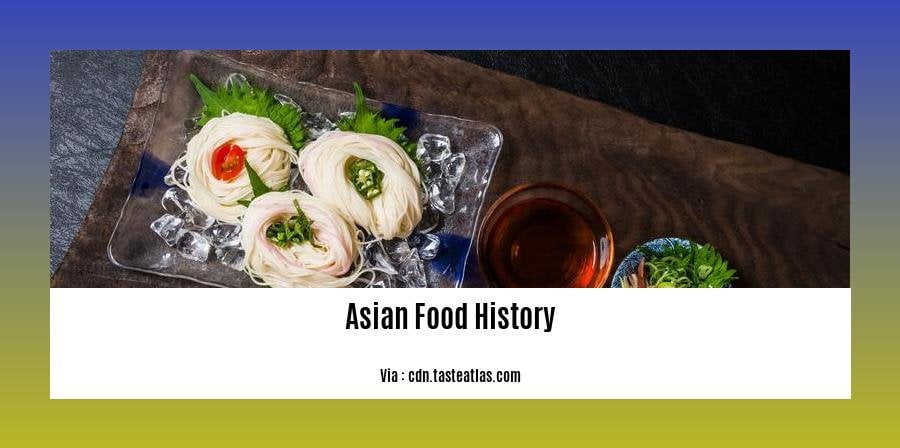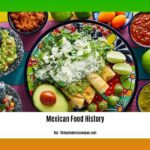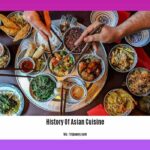Embark on a tantalizing journey through the rich tapestry of flavors and traditions that define Asian cuisine in the article titled “Asian Food History: A Culinary Voyage Through Time and Cultures.” From the ancient origins of rice cultivation to the vibrant street food markets of today, this exploration delves into the diverse culinary landscape of Asia, uncovering the influences that have shaped its unique flavors and the cultural significance of food in various Asian societies. Join us as we trace the evolution of iconic dishes, analyze culinary influences, and celebrate the diversity of Asian food, one delicious bite at a time.
Key Takeaways:
- Asian cuisine was influenced by European colonization, leading to the spread of ingredients and techniques.
- Mongolian cuisine blends Eastern and Western influences, shaping the food of Central Asian countries.
- North Asian cuisine is distinct from Russian cuisine, featuring unique regional ingredients and traditions.
- East Asia includes Chinese, Korean, Japanese, Taiwanese, Mongolian, and Tibetan cuisines, each with its own characteristics.
- Curry meals originated in the Indian subcontinent, using yogurt in the north and coconut milk in the south and Southeast Asia.
- Asian cuisine is shaped by history, culture, and environment, resulting in diverse culinary traditions.
- Asian cultures developed their own food traditions, often centered around family and group gatherings.
- Asian food encompasses a vast array of dishes, with each country or region showcasing its own specialties and techniques.
Asian Food History: A Culinary Voyage Through Time and Cultures
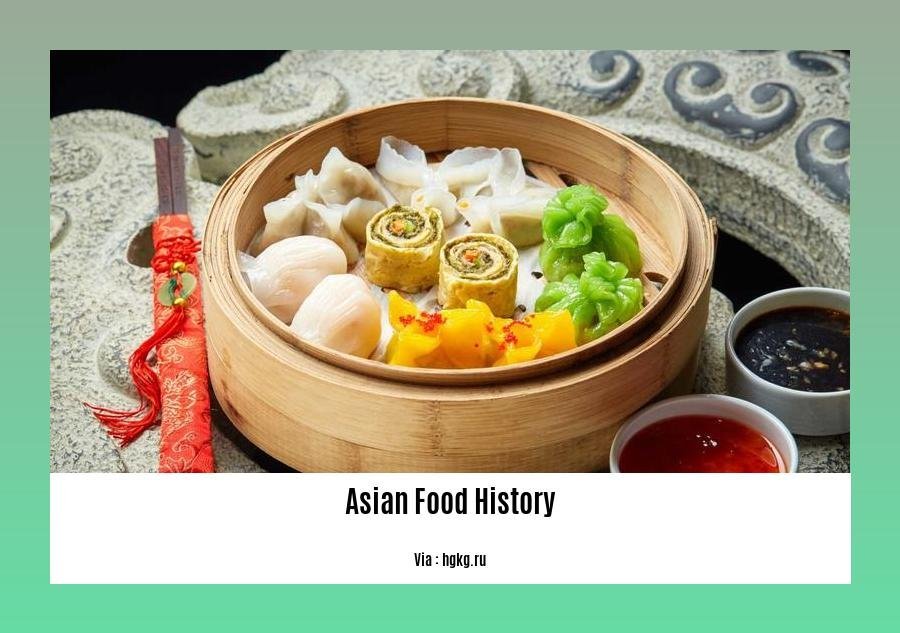
From the vibrant street food of Bangkok to the delicate artistry of Japanese cuisine, Asian food is a culinary tapestry that weaves together a rich history of flavors, traditions, and cultural influences. Join us on a journey through the annals of Asian food history, where we’ll explore the evolution of this diverse and captivating cuisine.
h3>A Fusion of Flavors: The Interplay of East and West
The culinary landscape of Asia has been shaped by a complex interplay of cultural exchanges and historical events. The arrival of European traders and colonizers in the region left an indelible mark on Asian food history, introducing new ingredients and cooking techniques that blended with existing culinary traditions. This fusion of flavors gave rise to unique dishes that showcased the best of both worlds, such as the aromatic curries of Southeast Asia, which incorporate European spices with local ingredients.
h3>The Silk Road: A Culinary Highway of Exchange
The Silk Road, a network of ancient trade routes that connected East and West, played a pivotal role in the exchange of culinary ideas and ingredients. Merchants and travelers carried exotic spices, fruits, and cooking techniques along these routes, facilitating the spread of culinary influences across vast distances. As a result, dishes like samosas, which originated in Central Asia, found their way to South Asia and beyond, becoming an integral part of local cuisines.
h3>Regional Diversity: A Symphony of Flavors
Asia’s vast geography and diverse cultures have given rise to a multitude of regional cuisines, each with its own unique character and culinary traditions. From the fiery Sichuan cuisine of China to the delicate flavors of Japanese kaiseki, the Asian food history is a testament to the region’s culinary diversity. Whether it’s the aromatic curries of India, the umami-rich dishes of Japan, or the vibrant street food of Southeast Asia, each region offers a distinct culinary experience that reflects its unique heritage and culture.
h3>Food as a Cultural Expression
In Asian cultures, food holds a profound significance, deeply intertwined with family, community, and religious traditions. Family meals are often a time for bonding and sharing stories, while communal feasts and festivals showcase the best of local cuisine. Food is also an integral part of religious ceremonies and celebrations, with specific dishes prepared to honor deities or commemorate special occasions.
h3>The Future of Asian Cuisine: Embracing Innovation and Tradition
As we look to the future of Asian food history, we see a culinary landscape that is both rooted in tradition and open to innovation. While many chefs are committed to preserving and celebrating traditional recipes, others are pushing boundaries and experimenting with new flavors and techniques. This spirit of culinary exploration promises to create exciting new dishes that honor the past while embracing the future.
So let’s embark on this culinary journey, exploring the rich history and diverse flavors of Asian cuisine. From the bustling food markets of Asia to the Michelin-starred restaurants showcasing modern interpretations of classic dishes, the Asian food history is a treasure trove waiting to be explored.
Did you know that the mixture of African, European, and Amerindian cuisines in the 15th century originated and laid the foundation for what we know today as the exciting and flavorful dishes of the Caribbean? To learn more about Caribbean food history and the unique culinary traditions of this vibrant region, explore the informative article here: caribbean food history.
Asian Food List: A Culinary Symphony of Flavors
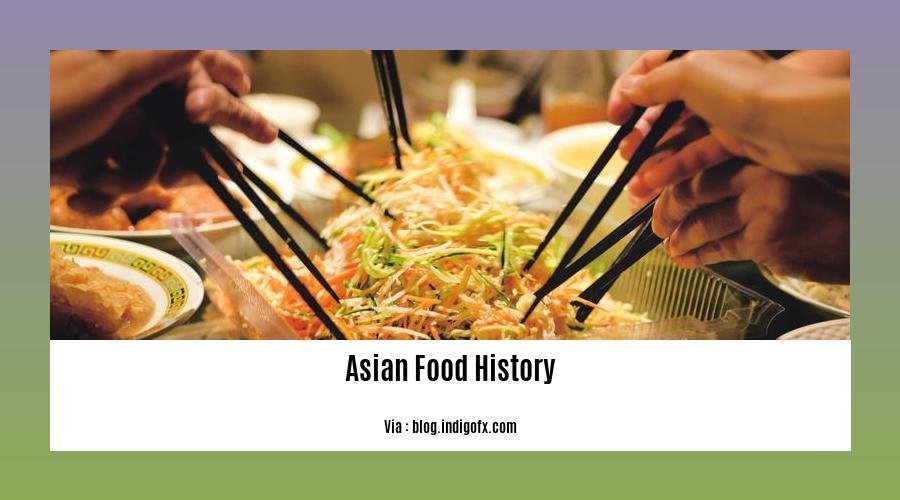
Throughout history, Asia’s diverse cultures have crafted a rich tapestry of flavors, resulting in a culinary symphony that delights the senses. From the delicate artistry of sushi to the robust warmth of curry, each dish narrates a tale of heritage and tradition.
Embarking on a Culinary Journey
Our culinary adventure begins in East Asia, where the iconic flavors of sushi, ramen, dim sum, and pad thai reign supreme. Sushi, with its pristine slices of raw fish and vinegared rice, epitomizes Japan’s dedication to precision and aesthetics. Ramen, a hearty noodle soup, showcases the depth of Japanese flavors, while dim sum, with its delicate dumplings and steamed buns, represents the Cantonese culinary prowess. Pad thai, Thailand’s national dish, tantalizes taste buds with its sweet, sour, and savory symphony.
Venturing into Central Asia, we encounter plov, a fragrant rice dish studded with succulent meat and vegetables. Samsa, a savory pastry filled with ground lamb or beef, embodies the region’s nomadic heritage. Korma, a creamy yogurt-based curry, and shashlik, tender meat skewers grilled to perfection, complete the culinary tapestry of this vibrant region.
Culinary Crossroads of Asia
The crossroads of Asia, where cultures converge and culinary traditions intertwine, is a treasure trove of flavors. India, the birthplace of curry, presents a kaleidoscope of spices, with regional variations that reflect the country’s diverse geography and history. Northern curries, influenced by the Mughal Empire, feature yogurt and nuts, while southern curries showcase the vibrant flavors of coconut milk.
Key Takeaway:
- Asian cuisine is a diverse tapestry of flavors, influenced by geography, climate, and cultural interactions.
- East Asian cuisines, such as sushi, ramen, dim sum, and pad thai, exemplify precision, depth of flavor, and aesthetic appeal.
- Central Asian cuisine, represented by dishes like plov, samsa, korma, and shashlik, reflects the region’s nomadic heritage and rich culinary traditions.
- The Indian subcontinent offers a symphony of curries, with regional variations that showcase the country’s diverse geography and history.
Sources
Asian Recipe: History and Evolution of Asian Cuisine
TasteAtlas: Asian Food: Top 100 Dishes
History of Asian Cuisine Ppt
Enjoy a culinary journey through the rich history of Asian cuisine, a tapestry of flavors and traditions that have captivated the world. Asian cuisine encompasses a diverse range of culinary traditions, each with its unique flavors, ingredients, and cooking techniques.
Key Takeaways:
- Historical Influences: Asian cuisine has been shaped by centuries of history, including cultural exchanges, trade routes, and migration patterns.
- Regional Diversity: Each Asian region boasts its unique culinary identity, influenced by geography, climate, and local ingredients.
- Culinary Techniques: Asian cuisines showcase a variety of cooking techniques, from stir-frying and steaming to pickling and fermentation.
- Ingredients Galore: Asian cuisine is renowned for its vibrant use of fresh ingredients, including vegetables, seafood, and spices.
- Cultural Significance: Food holds deep cultural significance in Asia, often tied to festivals, celebrations, and family gatherings.
A Culinary Journey Through Time
The history of Asian cuisine is a fascinating tale of cultural exchange and culinary innovation. From the ancient civilizations of China and India to the vibrant street food markets of Southeast Asia, Asian cuisine has been shaped by a multitude of factors.
- Trade routes, such as the Silk Road, facilitated the exchange of ingredients, spices, and cooking techniques across vast distances.
- Cultural interactions, including migrations and conquests, led to the blending of culinary traditions, resulting in new and exciting flavors.
- Local ingredients and climate played a crucial role in shaping regional cuisines, leading to the diverse culinary tapestry we see today.
A Diverse Culinary Landscape
Asian cuisine is renowned for its incredible diversity, with each region offering its unique culinary experiences.
- East Asia: A culinary powerhouse known for its precision and balance, East Asian cuisine encompasses countries like China, Japan, and Korea.
- South Asia: A vibrant and aromatic region, South Asian cuisine is characterized by its use of spices, yogurt, and coconut milk.
- Southeast Asia: A melting pot of flavors, Southeast Asian cuisine showcases a harmonious blend of sweet, sour, salty, and spicy tastes.
- Central Asia: A crossroads of cultures, Central Asian cuisine reflects the nomadic heritage of the region, with hearty dishes like plov and samsa.
Culinary Techniques: A Symphony of Flavors
Asian cuisine showcases a diverse array of culinary techniques, each contributing to its unique flavors and textures.
- Stir-frying: A quick and versatile technique that retains the vibrancy of fresh ingredients.
- Steaming: A gentle method that preserves the natural flavors and nutrients of food.
- Pickling: A traditional technique used to preserve vegetables and add tangy flavors.
- Fermentation: A process that transforms ingredients, creating complex flavors and aromas.
Ingredients: A Symphony of Flavors
Asian cuisine is renowned for its vibrant use of fresh ingredients, which provide a symphony of flavors and textures.
- Vegetables: A staple in Asian cooking, vegetables are used in a variety of dishes, from stir-fries to salads.
- Seafood: Abundant in coastal regions, seafood is a key ingredient in many Asian cuisines, adding a briny, umami flavor.
- Spices: Asian cuisine is known for its bold and aromatic spices, which add layers of flavor and complexity to dishes.
Cultural Significance: Food as a Way of Life
In Asia, food holds deep cultural significance, often tied to festivals, celebrations, and family gatherings.
- Family Meals: In many Asian cultures, family meals are a central part of daily life, fostering a sense of togetherness and community.
- Festivals and Celebrations: Food plays a significant role in festivals and celebrations, with special dishes prepared to mark these special occasions.
Conclusion: A Culinary Legacy
Asian cuisine is a testament to the rich history, cultural diversity, and culinary ingenuity of the Asian continent. With its diverse flavors, ingredients, and cooking techniques, Asian cuisine continues to captivate taste buds worldwide, leaving a lasting legacy on the global culinary landscape.
Citations:
[1] Davidson, A. (2006). The Oxford Companion to Food. Oxford University Press.
[2] Anderson, E. N. (2013). Food Culture in Asia: A Critical Introduction. Routledge.
FAQ
Q1: How did European colonization influence Asian cuisine?
A1: European colonization played a significant role in the evolution of Asian cuisine by introducing new ingredients and cooking techniques from various regions. This exchange led to the migration of ingredients and culinary practices across different parts of Asia.
Q2: What is the difference between North Asian and Russian cuisine?
A2: While North Asian cuisine shares similarities with Russian cuisine due to geographical proximity, it maintains distinct regional ingredients and traditions. North Asian cuisine incorporates influences from Siberian civilizations, resulting in a unique culinary identity.
Q3: What are the characteristics of South Asian cuisine?
A3: South Asian cuisine, originating from the Indian subcontinent, is renowned for its vibrant flavors and extensive use of spices. Dishes often feature complex blends of spices, herbs, and aromatics, creating a distinctive culinary experience.
Q4: What are some popular East Asian dishes?
A4: East Asian cuisine encompasses a diverse range of dishes, including sushi, ramen, and dim sum from China; pad thai and kung pao chicken from Thailand; and kimchi and bibimbap from Korea.
Q5: What factors have shaped Asian cuisine?
A5: Asian cuisine has been shaped by a combination of history, culture, and the environment. The unique geographical features, climate conditions, and cultural influences of each region have contributed to the development of diverse culinary traditions and dishes throughout Asia.
- Senior at What Age: Benefits & Eligibility Guide - March 29, 2025
- Unlocking Senior Benefits: How Old is a Senior? Your Complete Guide - March 29, 2025
- Master Russian Politeness:A Guide to Saying Please - March 29, 2025
